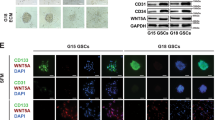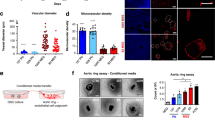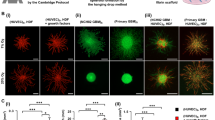Abstract
Novel therapeutic agents combined with innovative modes of delivery and non-invasive imaging of drug delivery, pharmacokinetics and efficacy are crucial in developing effective clinical anticancer therapies. In this study, we have created and characterized multiple novel variants of anti-angiogenic protein thrombospondin (aaTSP-1) that comprises unique regions of three type-I-repeats of TSP-1 and used engineered human neural stem cells (hNSC) to provide sustained on-site delivery of secretable aaTSP-1 to tumor-vasculature. We show that hNSC-aaTSP-1 has anti-angiogenic effect on human brain and dermal microvascular endothelial cells co-cultured with established glioma cells and CD133+ glioma-initiating cells. Using human glioma cells and hNSC engineered with different combinations of fluorescent and bioluminescent marker proteins and employing multi-modality imaging techniques, we show that aaTSP-1 targets the vascular-component of gliomas and a single administration of hNSC-aaTSP-1 markedly reduces tumor vessel-density that results in inhibition of tumor-progression and increased survival in mice bearing highly malignant human gliomas. We also show that therapeutic hNSC do not proliferate and remain in an un-differentiated state in the brains of glioma-bearing mice. This study provides a platform for accelerated development of future cell-based therapies for cancer.
This is a preview of subscription content, access via your institution
Access options
Subscribe to this journal
Receive 50 print issues and online access
$259.00 per year
only $5.18 per issue
Buy this article
- Purchase on Springer Link
- Instant access to full article PDF
Prices may be subject to local taxes which are calculated during checkout






Similar content being viewed by others
References
Aboody KS, Brown A, Rainov NG, Bower KA, Liu S, Yang W et al. (2000). Neural stem cells display extensive tropism for pathology in adult brain: evidence from intracranial gliomas. Proc Natl Acad Sci USA 97: 12846–12851.
Anderson JC, Grammer JR, Wang W, Nabors LB, Henkin J, Stewart Jr JE et al. (2007). ABT-510, a modified type 1 repeat peptide of thrombospondin, inhibits malignant glioma growth in vivo by inhibiting angiogenesis. Cancer Biol Ther 6: 454–462.
Asaishi K, Endrich B, Gotz A, Messmer K . (1981). Quantitative analysis of microvascular structure and function in the amelanotic melanoma A-Mel-3. Cancer Res 41: 1898–1904.
Batchelor TT, Sorensen AG, di Tomaso E, Zhang WT, Duda DG, Cohen KS et al. (2007). AZD2171, a pan-VEGF receptor tyrosine kinase inhibitor, normalizes tumor vasculature and alleviates edema in glioblastoma patients. Cancer Cell 11: 83–95.
Bergers G, Benjamin LE . (2003). Tumorigenesis and the angiogenic switch. Nat Rev Cancer 3: 401–410.
Bogdanov Jr A, Marecos E, Cheng HC, Chandrasekaran L, Krutzsch HC, Roberts DD et al. (1999). Treatment of experimental brain tumors with trombospondin-1 derived peptides: an in vivo imaging study. Neoplasia 1: 438–445.
Calabrese C, Poppleton H, Kocak M, Hogg TL, Fuller C, Hamner B et al. (2007). A perivascular niche for brain tumor stem cells. Cancer Cell 11: 69–82.
Capillo M, Mancuso P, Gobbi A, Monestiroli S, Pruneri G, Dell′Agnola C et al. (2003). Continuous infusion of endostatin inhibits differentiation, mobilization, and clonogenic potential of endothelial cell progenitors. Clin Cancer Res 9: 377–382.
Carmeliet P, Jain RK . (2000). Angiogenesis in cancer and other diseases. Nature 407: 249–257.
Corsten MF, Shah K . (2008). Therapeutic stem-cells for cancer treatment: hopes and hurdles in tactical warfare. Lancet Oncol 9: 376–384.
Drixler TA, Borel Rinkes IH, Ritchie ED, van Vroonhoven TJ, Gebbink MF, Voest EE . (2000). Continuous administration of angiostatin inhibits accelerated growth of colorectal liver metastases after partial hepatectomy. Cancer Res 60: 1761–1765.
Duda DG, Batchelor TT, Willett CG, Jain RK . (2007). VEGF-targeted cancer therapy strategies: current progress, hurdles and future prospects. Trends Mol Med 13: 223–230.
Ehtesham M, Kabos P, Gutierrez MA, Chung NH, Griffith TS, Black KL et al. (2002). Induction of glioblastoma apoptosis using neural stem cell-mediated delivery of tumor necrosis factor-related apoptosis-inducing ligand. Cancer Res 62: 7170–7174.
Gondi CS, Lakka SS, Dinh DH, Olivero WC, Gujrati M, Rao JS . (2004). Downregulation of uPA, uPAR and MMP-9 using small, interfering, hairpin RNA (siRNA) inhibits glioma cell invasion, angiogenesis and tumor growth. Neuron Glia Biol 1: 165–176.
Guerin C, Laterra J . (1997). Regulation of angiogenesis in malignant gliomas. Exs 79: 47–64.
Hanahan D, Weinberg RA . (2000). The hallmarks of cancer. Cell 100: 57–70.
Hoekstra R, de Vos FY, Eskens FA, de Vries EG, Uges DR, Knight R et al. (2006). Phase I study of the thrombospondin-1-mimetic angiogenesis inhibitor ABT-510 with 5-fluorouracil and leucovorin: a safe combination. Eur J Cancer 42: 467–472.
Jain RK, di Tomaso E, Duda DG, Loeffler JS, Sorensen AG, Batchelor TT . (2007). Angiogenesis in brain tumors. Nat Rev Neurosci 8: 610–622.
Kisker O, Becker CM, Prox D, Fannon M, D'Amato R, Flynn E et al. (2001). Continuous administration of endostatin by intraperitoneally implanted osmotic pump improves the efficacy and potency of therapy in a mouse xenograft tumor model. Cancer Res 61: 7669–7674.
Kock N, Kasmieh R, Weissleder R, Shah K . (2007). Tumor therapy mediated by lentiviral expression of shBcl-2 and S-TRAIL. Neoplasia 9: 435–442.
Lawler J, Detmar M . (2004). Tumor progression: the effects of thrombospondin-1 and -2. Int J Biochem Cell Biol 36: 1038–1045.
Liu P, Wang Y, Li YH, Yang C, Zhou YL, Li B et al. (2003). Adenovirus-mediated gene therapy with an antiangiogenic fragment of thrombospondin-1 inhibits human leukemia xenograft growth in nude mice. Leuk Res 27: 701–708.
Markovic SN, Suman VJ, Rao RA, Ingle JN, Kaur JS, Erickson LA et al. (2007). A phase II study of ABT-510 (thrombospondin-1 analog) for the treatment of metastatic melanoma. Am J Clin Oncol 30: 303–309.
Montet X, Figueiredo JL, Alencar H, Ntziachristos V, Mahmood U, Weissleder R . (2007). Tomographic fluorescence imaging of tumor vascular volume in mice. Radiology 242: 751–758.
Naldini L, Blomer U, Gage FH, Trono D, Verma IM . (1996). Efficient transfer, integration, and sustained long-term expression of the transgene in adult rat brains injected with a lentiviral vector. Proc Natl Acad Sci USA 93: 11382–11388.
Papetti M, Herman IM . (2002). Mechanisms of normal and tumor-derived angiogenesis. Am J Physiol Cell Physiol 282: C947–C970.
Rusk A, McKeegan E, Haviv F, Majest S, Henkin J, Khanna C . (2006). Preclinical evaluation of antiangiogenic thrombospondin-1 peptide mimetics, ABT-526 and ABT-510, in companion dogs with naturally occurring cancers. Clin Cancer Res 12: 7444–7455.
Sasportas LS, Kasmieh R, Wakimoto H, Hingtgen S, van de Water JA, Mohapatra G et al. (2009). Assessment of therapeutic efficacy and fate of engineered human mesenchymal stem cells for cancer therapy. Proc Natl Acad Sci USA 106: 4822–4827.
Shah K, Bureau E, Kim DE, Yang K, Tang Y, Weissleder R et al. (2005). Glioma therapy and real-time imaging of neural precursor cell migration and tumor regression. Ann Neurol 57: 34–41.
Shah K, Hingtgen S, Kasmieh R, Figueiredo JL, Garcia-Garcia E, Martinez-Serrano A et al. (2008). Bimodal viral vectors and in vivo imaging reveal the fate of human neural stem cells in experimental glioma model. J Neurosci 28: 4406–4413.
Shah K, Tang Y, Breakefield X, Weissleder R . (2003). Real-time imaging of TRAIL-induced apoptosis of glioma tumors in vivo. Oncogene 22: 6865–6872.
Shah K, Tung CH, Yang K, Weissleder R, Breakefield XO . (2004). Inducible release of TRAIL fusion proteins from a proapoptotic form for tumor therapy. Cancer Res 64: 3236–3242.
Tang Y, Shah K, Messerli SM, Snyder E, Breakefield X, Weissleder R . (2003). in vivo tracking of neural progenitor cell migration to glioblastomas. Hum Gene Ther 14: 1247–1254.
Tuettenberg J, Friedel C, Vajkoczy P . (2006). Angiogenesis in malignant glioma—a target for antitumor therapy? Crit Rev Oncol Hematol 59: 181–193.
Verhaegent M, Christopoulos TK . (2002). Recombinant gaussia luciferase. Overexpression, purification, and analytical application of a bioluminescent reporter for DNA hybridization. Anal Chem 74: 4378–4385.
Zagzag D, Amirnovin R, Greco MA, Yee H, Holash J, Wiegand SJ et al. (2000). Vascular apoptosis and involution in gliomas precede neovascularization: a novel concept for glioma growth and angiogenesis. Lab Invest 80: 837–849.
Zhang X, Connolly C, Duquette M, Lawler J, Parangi S . (2007). Continuous administration of the three thrombospondin-1 type 1 repeats recombinant protein improves the potency of therapy in an orthotopic human pancreatic cancer model. Cancer Lett 247: 143–149.
Acknowledgements
This work was supported by American Cancer Society (KS), Goldhirsh foundation (KS), Alliance for Cancer Gene Therapy (KS), P50 CA86355 (KS, RW), R21CA131980 (KS). We thank Dr Rainer Koehler for his help with intravital microscopy and Dr Claudio Vinegoni for his help with processing images. We also thank Dr Jack Lawler (Beth Israel Deaconess Hospital, Boston) for providing us with TSP-1 cDNA construct and Dr Paul van Bergen en Henegouwen (Utrecht University, The Netherlands) for his constructive comments.
Author information
Authors and Affiliations
Corresponding author
Ethics declarations
Competing interests
The authors declare no conflict of interest.
Additional information
Supplementary Information accompanies the paper on the Oncogene website
Rights and permissions
About this article
Cite this article
van Eekelen, M., Sasportas, L., Kasmieh, R. et al. Human stem cells expressing novel TSP-1 variant have anti-angiogenic effect on brain tumors. Oncogene 29, 3185–3195 (2010). https://doi.org/10.1038/onc.2010.75
Received:
Revised:
Accepted:
Published:
Issue Date:
DOI: https://doi.org/10.1038/onc.2010.75
Keywords
This article is cited by
-
The Contributions of Thrombospondin-1 to Epilepsy Formation
Neuroscience Bulletin (2024)
-
Mesenchymal stem/stromal cells in cancer therapy
Journal of Hematology & Oncology (2021)
-
Triple-negative breast cancer: new treatment strategies in the era of precision medicine
Science China Life Sciences (2021)
-
Gene Delivery Approaches for Mesenchymal Stem Cell Therapy: Strategies to Increase Efficiency and Specificity
Stem Cell Reviews and Reports (2017)
-
Stem cell delivery of therapies for brain disorders
Clinical and Translational Medicine (2014)



